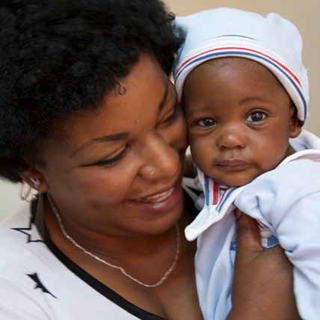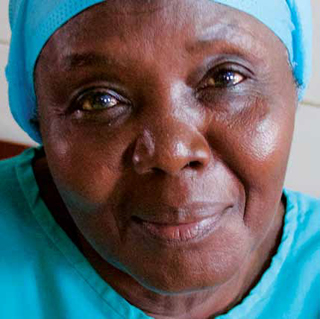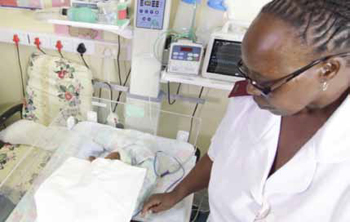Dr. Arthur Ammann's career has spanned many fields, including physician, researcher, activist, philanthropist, and clinical professor of pediatric immunology at the University of California, San Francisco Medical Center.
In 1977, Dr. Ammann discovered several new diseases, and performed the clinical trials that resulted in FDA approval of the first pneumococcal vaccine that prevented bacterial pneumonia and meningitis. That discovery has saved millions of lives, especially of children and the elderly.
In 1982, Dr. Ammann described two of the three ways that HIV is transmitted, including the first cases of transmission of AIDS from mother to infant, and the first blood transfusion associated AIDS patients.
Dr. Ammann has authored over 450 scientific papers and book chapters. He has served with many organizations, including the National Institutes of Health Advisory Committees, AIDS Planning Committee of the Institute of Medicine of the National Academy of Sciences, the Pediatric AIDS Foundation, the American Foundation for AIDS Research, and Genentech. In 1997, Ammann founded Global Strategies for HIV Prevention.
Dr. Ammann has received honors from more than 60 national and international organizations, including the U.S. Surgeon General Award for Research, the U.S. Public Health Service Fellowship Award, and the Heroes in Medicine Award by the International Association of Physicians in AIDS Care.
For more, see here, lethaldecisions.com.
Dan: Thanks for your continued support for JwJ. Since 2008, you've written an essay for us on World AIDS Day, which usually falls during the season of Advent.
Art Ammann: Dan, thank you for this important opportunity to talk about some of the most neglected individuals in the HIV epidemic, the involvement of the Christian community, and what we as Christians need to do now.
 |
The first World AIDS Day was December 1, 1988. The purpose was to raise awareness of the dramatic worsening of the AIDS epidemic. Since 1988, the epidemic has continued, in spite of widespread attention given to World AIDS Day and its clever slogans. When you first asked me to write an essay about World AIDS Day associated with the Advent season, I hesitated briefly and then agreed. My feeling had long been that the tragic suffering of those affected by HIV/AIDS was an opportunity for the Christian community to respond with the compassion that we had all been taught in the Gospels. What better event to link Christian belief and hope to suffering? However, it was become increasingly difficult to acknowledge that World AIDS Day was not having a sufficient impact, either in the secular or the Christian world, as the epidemic continued to spiral upwards at the rate of more than 2 million new infections in men, women, and children each year, and an equal number of deaths. I recall one of my essays for JwJ being on “voyeurism” — reading, hearing, witnessing terrible tragedies, but then walking away without taking responsibility.
Can we talk about some specifics? It was my privilege to join you on a trip to Liberia in 2006.
That was only three years after the Liberian Civil War in 2003. What transpired in Liberia during the rebellion was short of miraculous as far as world politics goes. A group of women led a revolt against the tyrannical President Charles Taylor. They were successful in ultimately getting him arrested and put on trial for crimes against humanity. One of the many brave woman leaders was Leymah Gbowee, who won a Nobel peace prize for leading the women's peace movement. Another was Ellen Johnson Sirleaf, who in 2005 became the first woman president of an African country. Gbowee’s book, Mighty Be Our Powers: How Sisterhood, Prayer, and Sex Changed a Nation at War, chronicles the events. You and I spent time with another woman hero — the surgeon Dr. Lily Sanvee, director of St. Joseph’s Hospital in Monrovia. She withstood the vicious onslaught of rebel forces seeking to destroy everything, including her hospital that brought healthcare to impoverished people. It seemed as if nothing could stop her dedication to the people of Liberia, that is, until the Ebola virus epidemic hit and she lost the hospital director, several nurses, and laboratory technicians. The hospital itself was eventually closed. Dr. Sanvee is once again part of Liberia’s recovery, reminding me of Philippians 1:6: “I am sure of this, that he who began a good work in you will bring it to completion at the day of Jesus Christ.”
I was thinking — the summer 2017 will mark thirty-five years since you made two startling discoveries — that AIDS had passed from a mother to her three children, and, in a separate case, that it had been contracted through blood transfusion.
Thirty-five years is a long time, and yet I can remember the details of the very first patients. Our laboratory was the only one in San Francisco conducting immunology tests on the young gay men who were developing AIDS. In 1981, we didn’t know the cause of AIDS, so we had only immunological tests to identify what we were dealing with — a lethal new disease. Previous to the AIDS epidemic, we had set up studies of immunity to diagnose young infants who were born with rare genetic immunodeficiency diseases. In 1982, we noticed that we were seeing children with a very different immunologic profile than an inherited form of disease, but nonetheless similar to what we were seeing in adults with AIDS. At first we couldn’t understand how young infants could have an immunodeficiency disorder like AIDS, especially since the suspicion was that AIDS was a result of having multiple sexual partners. It took a while before we could convince ourselves that the infants had the same disease, but instead of sexual transmission, it was transmitted from mothers to infants, and in one instance, from a blood transfusion from an individual with AIDS. We wanted to publish our observations in the medical journals, but the articles were rejected. It was not until 1984 when a blood test became available to diagnose HIV infection that the story of HIV transmission could be confirmed. I must say that it was difficult when we presented our findings at medical meetings. So many scientists objected to our conclusions, stating that AIDS couldn’t occur in infants and children. Within years, however, thousands of cases in children were being reported as the epidemic expanded and the extent of HIV infection in poor countries was documented.
This was a tragic diagnosis because the disease was at that time fatal. Equally devastating were the implications — did you think at that time that it would become a global epidemic?
Early in the epidemic, a group of us would gather weekly in the faculty club at the University of California for lunch and discuss the patients that we were seeing that had similar clinical and laboratory abnormalities that represented a new disease for which there was not even a name. Dr. Volberding was seeing young men with unusual infections, swollen lymph nodes, but also with low blood platelets that caused them to bleed. He was a hematologist. Dr. Greenspan, an oral surgeon, was seeing young men with unusual infections but who also had oral cancer. Dr. Conant was a dermatologist observing a dramatic increase in young men with a rare skin cancer called Kaposi’s sarcoma. As numbers of patients seen by these physicians increased weekly, we were beginning to see infants with AIDS. There’s no question that we felt we were at the cusp of a new epidemic, but up until 1983 we didn’t know the cause and we didn’t have a way of making a specific diagnosis. That all changed in 1985 when a specific test for the virus that caused AIDS allowed us to make a diagnosis in the early stages of AIDS. Our fears that this was going to be a global epidemic were confirmed. The number of new cases of AIDS increased exponentially until it was no longer in the thousands but in the millions.
In your new book, Lethal Decisions: The Unnecessary Deaths of Women and Children from HIV/AIDS (Nashville: Vanderbilt University Press, 2017), I was surprised that you have two chapters on "denialism." Many people didn't want to believe or to act upon your conclusions or the conclusions of other eminent scientists that HIV, a virus, was the cause of AIDS. The New England Journal of Medicine refused to publish your results. The blood banks of the American Red Cross opposed screening blood donors. An eminent tenured professor at the University of California at Berkley claimed that AIDS was a result of poverty and not a virus.
It did not take long for denialism to creep into the AIDS epidemic. By denialism I mean individuals who said that AIDS was an invented disease by scientists who were trying to make themselves famous or drug companies that wanted to get rich on treatments. There is a popular misconception that scientists are open to new information. Yet when you read medical history you find that some of the strongest objections to new discoveries come not from the nonscientific community, but from scientists themselves. Whether this is because of envy or because some individuals just require more proof before believing something is not clear. But there’s no question that denialism in its severest forms resulted in the unnecessary deaths of hundreds of thousands of individuals from AIDS. The most puzzling of the denialists was Professor Duesberg, a tenured professor at the University of California in Berkeley and member of the National Academy of Sciences, who wrote articles and a book claiming that HIV was not the cause of AIDS. Instead, he claimed that poverty and the drugs used to treat AIDS resulted in AIDS, disease progression, and death. Duesberg had a strong following as a result of the misinformation he transmitted over the Internet. One believer in his denialism was Mbeki, the president of South Africa, a country that had the largest percentage of HIV-infected individuals. His denialism resulted in delays in getting prevention and treatment to the people who needed it the most.
 |
In another instance, I was called to testify in court in Oregon about a case were an HIV-infected mother wanted to breast-feed her baby. Had she done so, in all likelihood, it would have resulted in the transmission of fatal HIV infection from breast milk to her infant. She had gotten on the Internet site and read about HIV denialism. Fortunately, the district attorney and the judge that dealt with the case determined that regardless of the mother’s beliefs, the baby needed to be protected. Other instances of denialism did not turn out well. Some HIV-infected adults who believed Duesberg stopped their treatment and eventually died. Unfortunately, the media found the “headlines” of HIV-infected patients refusing to take treatment of greater interest than their subsequent deaths that could’ve been prevented had they taken their medications. They reported the patients' denialism but not their deaths.
You don't mention it in your book, but I know from our many talks that you have also experienced foot dragging and "denialism" in our churches, especially early on. What kind of denialism were you referring to?
When I began to see the extent of the suffering in young gay men as a consequence of AIDS, and the expansion to women who were struggling to take care of themselves and their children, I felt that it was an opportunity for Christians to follow the teachings of Jesus and respond with compassion to a devastating disease and its impact on individuals, families, and the community. Jesus never differentiated on how or why a person got sick, no matter how much he was pushed to blame an individual’s illness on their behavior. He especially welcomed those who were on the periphery of society — who were discriminated against by the elite. One of the most damaging things that can happen to an individual who is sick is to be blamed for their illness, whether it’s cancer, an automobile accident, a stroke, or in this case, AIDS. The Christian church was given an opportunity to show just how strongly they believed in what Jesus had taught, but they were failing. This is not to say that Christian responses were absent. Many Christians who saw the intensity of the suffering and the impact on families and communities did what they could to promote acceptance and reduce discrimination, and most of all to show the forgiveness that they believed in.
You say the lesson you learned here is that "denialism in all forms should be taken seriously." (49). Can you give us other examples other than HIV and AIDS?
There is always a doubting Thomas. But there is a difference between doubts that are directed at finding the truth and strengthening the truth and denialism that refuses to look at the truth, and instead, tries to find anything that supports a predetermined conclusion, even if it is wrong. We see a lot of denialism in medicine — smoking a few cigarettes each day isn’t going to give me lung cancer; living a lifestyle that increases my blood pressure isn’t going to result in a stroke; immunizations are dangerous and result in autism, therefore I’m not going to give my child any immunizations because the risk of getting measles or polio is small compared to getting autism; or my husband doesn’t abuse me, he just loses his temper sometimes.
In addition to denialism, the AIDS epidemic has also been, perhaps paradoxically, plagued by horrible discrimination. You have provided special advocacy for women and children in the poorest parts of the poorest countries of the world (like war zones). Michael Gottlieb of UCLA, who identified the first case of AIDS in 1981, has called you "the conscience of the pediatric HIV epidemic."
It's about defending women and children. But it's not new. One can go back three or four centuries and look at paintings of women who have been blamed for adultery, or read books with the same theme. It is interesting to me that Jesus specifically addressed the issue of discrimination against women by religious leaders. He used the examples of the woman taken in adultery and the Samaritan woman at the well. Discrimination against women by blaming them of being HIV infected combines both denialism (the man is not at fault), and unjustly promotes discrimination by absolving men of any culpability.
I always felt that women and children needed special protection. Perhaps that’s why I went into the field of pediatrics. Much of my training was in inner-city environments where poverty and abuse were overt, but I learned that abuse of women and children occurred also in settings of wealth and education but was more easily hidden. The more I experienced, the stronger I felt that women and children required special advocates and special protection. I realized why the Old Testament and Jesus focused so directly on women, orphans, the poor, and refugees.
 |
I read your new book as a highly personal, deeply passionate, and even polemical history of the AIDS epidemic. Is that a fair assessment?
If by polemical you mean an attack on clinical research and its abuses, I don’t think that was where I was trying to end up. I felt I needed to point out the problems but then conclude that clinical research is important — it has so much potential to cure the pain and suffering of disease throughout the world. But it must be conducted with high scientific and ethical principles that do not harm others, especially the poor, women, and children. Part one of the book focuses on the extraordinary discoveries that found the cause of AIDS, then developed the laboratory tests to diagnose HIV infection, and finally developed more than 20 drugs to prevent and treat HIV. It should have been the beginning of taking all those scientific advances and eliminating the HIV epidemic. But it didn’t happen. That’s what part two of the book is about. I witnessed decisions made on who was viewed as important and who was considered disposable. Research studies in the US never withheld treatment for an individual to obtain statistical data, but they did that in hundreds of thousands of women and children in poor countries. That’s the ghost of Tuskegee all over again, when penicillin was withheld from black men with syphilis to do research on the course of untreated disease. What was hard for me to understand in the epidemic was how the academy, which laid claim to the purpose of research as being to rid humanity of disease, instead refused to deliver the life saving benefits of their research to those who needed it the most.
Today "an estimated twenty-one million (59 percent of) HIV-infected individuals are still not on any treatment (UNAIDS 2016)" (277). If you are lucky enough to live in a wealthy country, you have access to state of the art drugs that now control HIV. Magic Johnson, for example, publicly announced that he had HIV way back in 1991. But in parts of Africa today you call AIDS a "hyper epidemic" (281), and in your introduction "an ongoing disaster."
My book is being published at the same time of national discussions about the value of individuals. It’s black lives matter, women’s lives matter, and others saying that their lives matter too. In America, HIV/AIDS was taken up as a cause by prominent individuals when their communities were affected. But there are thousands in America that are invisible who are not diagnosed until the disease is advanced and difficult to treat. The situation in resource poor countries is worse. HIV is reported not by name but by numbers — 2 million new infections, 1.5 million deaths. But those numbers are composed of individuals with names. When individuals become numbers and are far removed from us physically and emotionally, we can tolerate vast differences in poverty, health, and in justice itself.
So, in wealthy countries the rates of HIV infection eventually plummeted, whereas in poor countries they skyrocketed. And in those poor countries, the hardest hit were women and children.
The contrast between wealthy countries and poor countries is increasing. The number of new HIV infections in the US started to fall in 1985, and now there are 50% fewer new infections each year. In the US, there are fewer than 100 infants who get infected each year, and in San Francisco, one of the first cities where AIDS was identified, there have been no new infections for the last five years. These results are what you want to see when scientific discoveries and clinical research are successfully applied. But if we see the benefit confined to wealthy countries alone, then we are betraying the primary goal of clinical research — to improve the health of people worldwide. Sadly, we are also betraying the fundamental ethical principles of justice and equity.
Why has treating pregnant women and children been mired in so much controversy for so long? You say you found yourself "pulled into defending what we felt had been unequivocally proven by science." (39).
Throughout the epidemic there has been stigma and discrimination. HIV in adults is a sexually transmitted infection or a result of drug abuse. Although much of the early discrimination was against gay men, much has changed in the US as a result of strong political and social influences. But women and children, especially those who are poor and of minority status, are unable to defend themselves legally, socially, politically, personally, and even in their right to equal health, including obtaining lifesaving prevention and treatment. In research studies, treatment was withheld from women and children but not men. It was easier to discriminate again children such as the brothers with hemophilia and HIV in Florida whose house was burned down, and the paperboy in Indiana who was prevented from going to school and whose customers canceled the delivery of the newspaper to their homes. We know from world history that those who do not have advocates, or in the case of HIV/AIDS — activists and advocates, will be subject to stigma and discrimination. It’s for these reasons that women and children need special protection and require individuals and groups to defend their rights. But where are the activists, advocates, and defenders of women and children in poor countries? Who will prevent these women and children from being used as mere chattel for research into new drugs for rich countries, and then abandoned when they cannot afford the drugs in their own countries?
 |
You urge scientists not to forget that "behind the test tubes and computer printouts there are real people suffering from a deadly infection." (83).
Most researchers are either PhD scientists or MD clinical researchers. The PhD researchers use advanced scientific methodologies to understand basic human biology and how disease occurs. MD researchers usually come from a background of observing the consequences of disease in their patients and wanting to eliminate disease, either by preventing it or by bringing it under control with treatment. The potential for science to solve many of today’s health problems is enormous, and in fact so great that discoveries are outpacing the ability to evaluate the discoveries. Going from discovery to implementation is often a long and expensive process that includes unavoidable obstacles such as strictly defined clinical research criteria and federally mandated procedures that must be followed for drugs or vaccines to be approved. Basic science and clinical research are based on raising a question or hypothesis that needs to be proven. It is often called evidence-based research. As funding for research rose dramatically, from millions of dollars to tens of billions of dollars, and as discoveries also increased significantly, the drive to be successful increased as well. Success demanded proof and created a demand for research subjects that could be easily and inexpensively accessed. There also were increasing calls for loosening or even eliminating scientific and ethical oversight. Even physicians, who are obligated to protect and act on behalf of their patients and demand the best of treatment, began engaging in clinical research that denied, rather than promoted treatment. Patients lost their identity and became numbers that could be analyzed statistically. When physicians deny their obligation to protect patients from harm, catastrophic research studies that withhold treatment from individuals who are poor minorities, such as those of Tuskegee and Guatemala, will be repeated ― perhaps even on a much larger scale.
At the end of your book, you write that "the story told in this book is one of hope and caution" (293). There have been both "extraordinary advances" and "tragic consequences" since 1981.
In a real sense, the history of the pediatric HIV/AIDS epidemic is a story of two epidemics. The first is about the success of prevention and treatment in wealthy countries such as America, while the other is the story of an epidemic that has continued far too long, to the point, as Albert Camus says in The Plague, that "it lost its fleshy substance.” Poor people, those who are sick, those who are economically and politically powerless, and those who live in distant countries, only become real when they become individuals whose suffering becomes palpable. The people with HIV that I meet with in poor countries are fathers, mothers, and children who are no different in their hopes and dreams than the people I meet in this country. They want to be healthy, they want to be secure, they want to have food and housing and have education for their children. They deserve the same dignity that we provide to our neighbors and friends. I believe that my book talks about that. But the book also calls for hope and action. It tells us that we cannot assume that success will be distributed in a manner that satisfies our demands for justice and equity. That is where our efforts should now be directed, and the Christian community should be a leader and emulate the teachings of their Founder.
Image credits: (1–4) GlobalStrategies.org.


